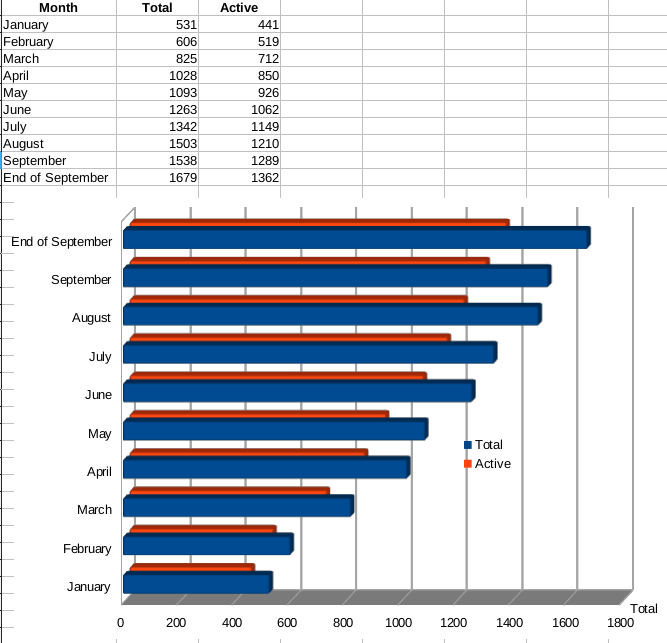Along with or along the lines of "Linux on the desktop" (PC Magazine claims 2021 Is the Year of Linux on the Desktop)

Gemini Lupa stats as OpenDocument Format (ODF)
Summary: We've decided to chart or produce a graph with some of the publicly-available numbers from Lupa, the Gemini protocol spider of Stéphane Bortzmeyer (bortzmeyer.org)
THE investment we've put into Gemini paid off; more so than IPFS for reasons that we explained yesterday.
The numbers shown in the graph (and spreadsheet) above are not complete, but they're the closest approximation we currently have because Geminispace (or Gemini space) is not centralised. The raw data comes from
past stats and
present stats. These do stress
upfront: “There are several reasons why many URIs are not in the database: * the capsule may forbid retrieval, through robots.txt, * we do not know all the URIs and some cannot be found from the ones we know [...] 1186 (87.1 %) capsules are self-signed, 139 (10.2 %) use the Certificate Authority Let’s Encrypt, 37 (2.7 %) are signed by another CA (may be not a trusted one).”
CAs are part of the centralisation trap we've often spoken about. Web browsers actively
encourage this centralisation if not
monopolisation by issuing exceptionally nasty warnings to people (if not outright blocking access).
Here is what the monthly reports say or said.
Today (29
th of September):
"There are 1679 capsules. We successfully connected recently to 1362 of them."
Start of September:
"There are 1538 capsules. We successfully connected recently to 1289 of them."
Start of August:
"There are 1503 capsules. We successfully connected recently to 1210 of them."
Start of July:
"There are 1342 capsules. We successfully connected recently to 1149 of them."
Start of June:
"There are 1263 capsules. We successfully connected recently to 1062 of them."
Start of May:
"There are 1093 capsules. We successfully connected recently to 926 of them."
Start of April:
"There are 1028 capsules. We successfully connected recently to 850 of them."
Start of March:
"There are 825 capsules. We successfully connected recently to 712 of them."
Start of February:
"There are 606 capsules. We successfully connected recently to 519 of them."
Start of January:
"There are 531 capsules. We successfully connected to 441 of them."
December 22nd:
"There are 506 capsules. We successfully connected to 415 of them."
We've been feeling this phenomenal growth ourselves, as traffic doubles every 2 months or so. In the month of September: (
so far)
21236 requests on September 1
20951 requests on September 2
8955 requests on September 3
8087 requests on September 4
7986 requests on September 5
8876 requests on September 6
29780 requests on September 7
41844 requests on September 8
8853 requests on September 9
9048 requests on September 10
9206 requests on September 11
10052 requests on September 12
13739 requests on September 13
9981 requests on September 14
12974 requests on September 15
10816 requests on September 16
10497 requests on September 17
10056 requests on September 18
12172 requests on September 19
11829 requests on September 20
8993 requests on September 21
20090 requests on September 22
11978 requests on September 23
10986 requests on September 24
10649 requests on September 25
15293 requests on September 26
14994 requests on September 27
13672 requests on September 28
That's about 13.8k page requests per day (0.16 per second) or more than double what we got last month. Most accessed URLs for the given day (or a prior day) can be
seen here. Over the Web we average about 4.7 per second, i.e. 34 times higher than the above rate. But currently a lot more people use the Web than Gemini; that can change in the more distant future.
⬆

